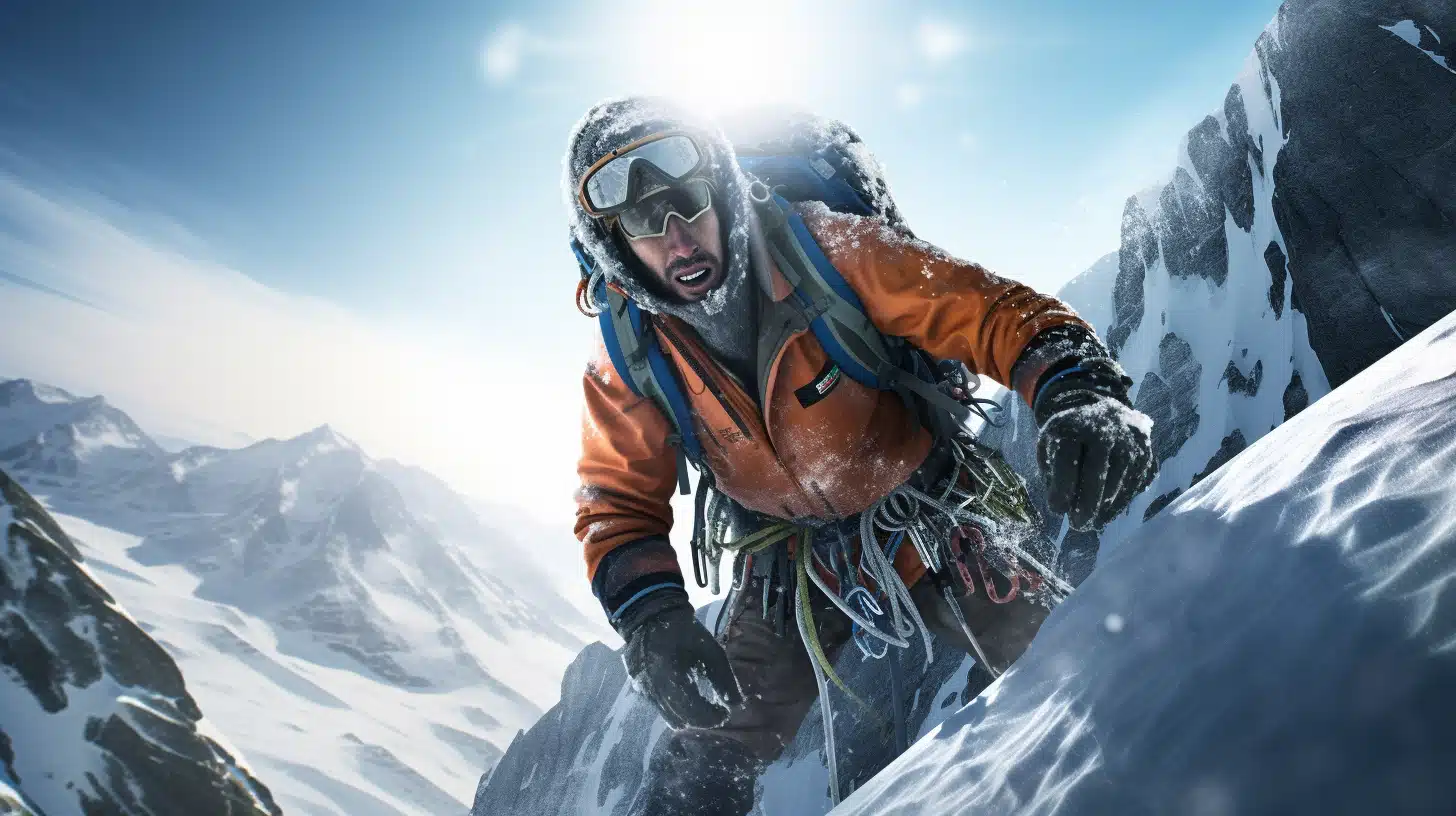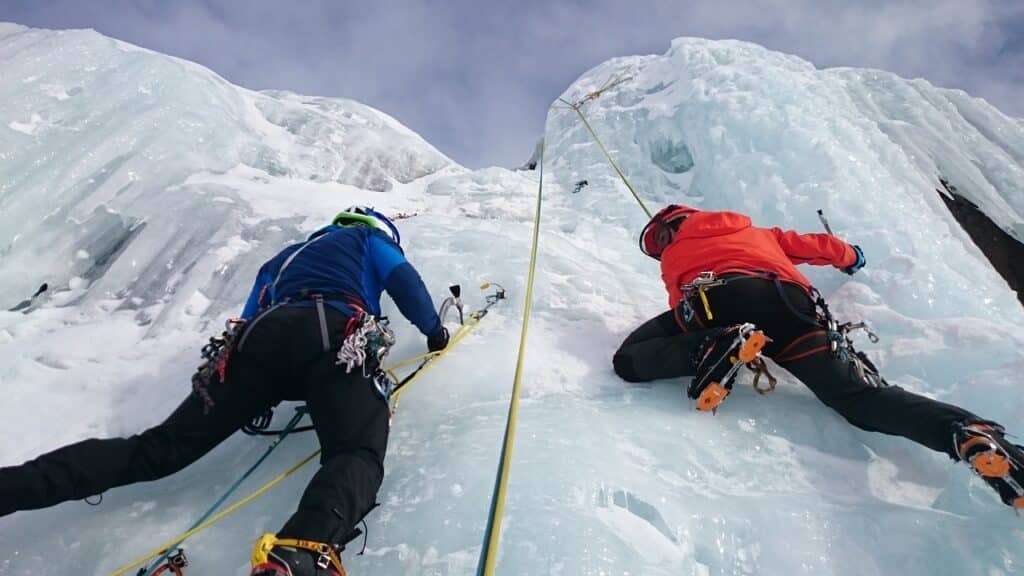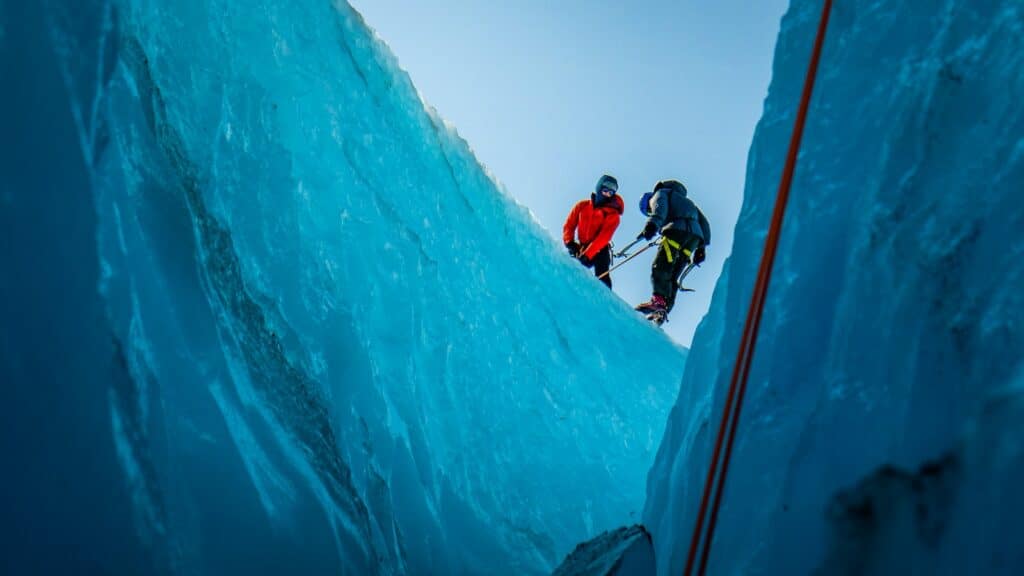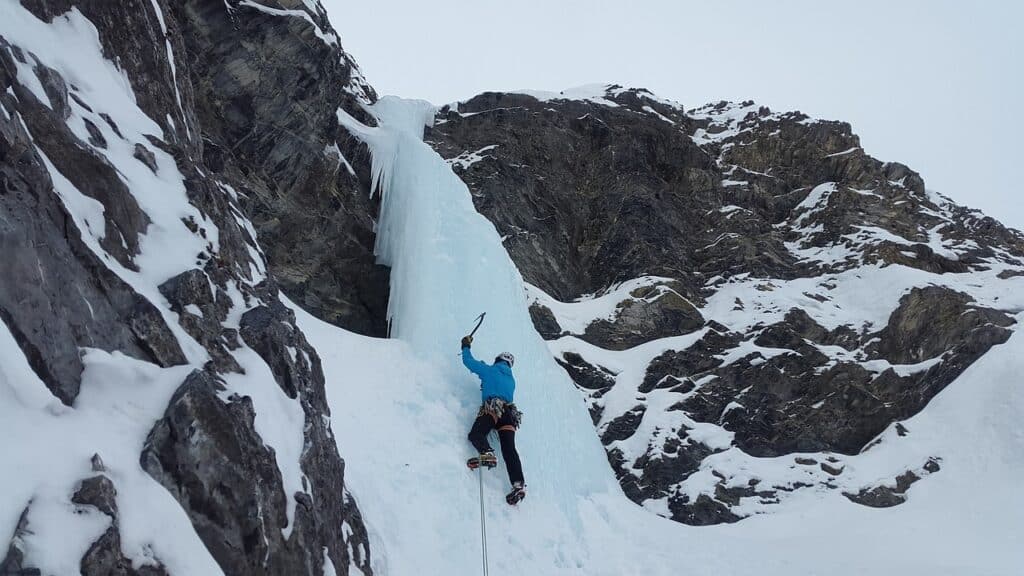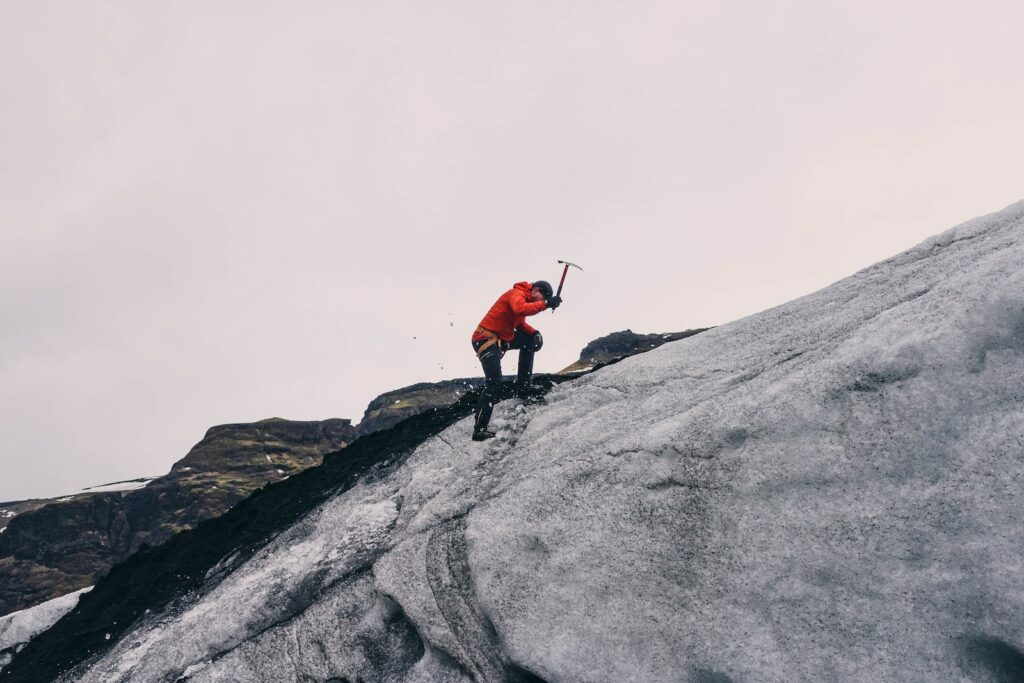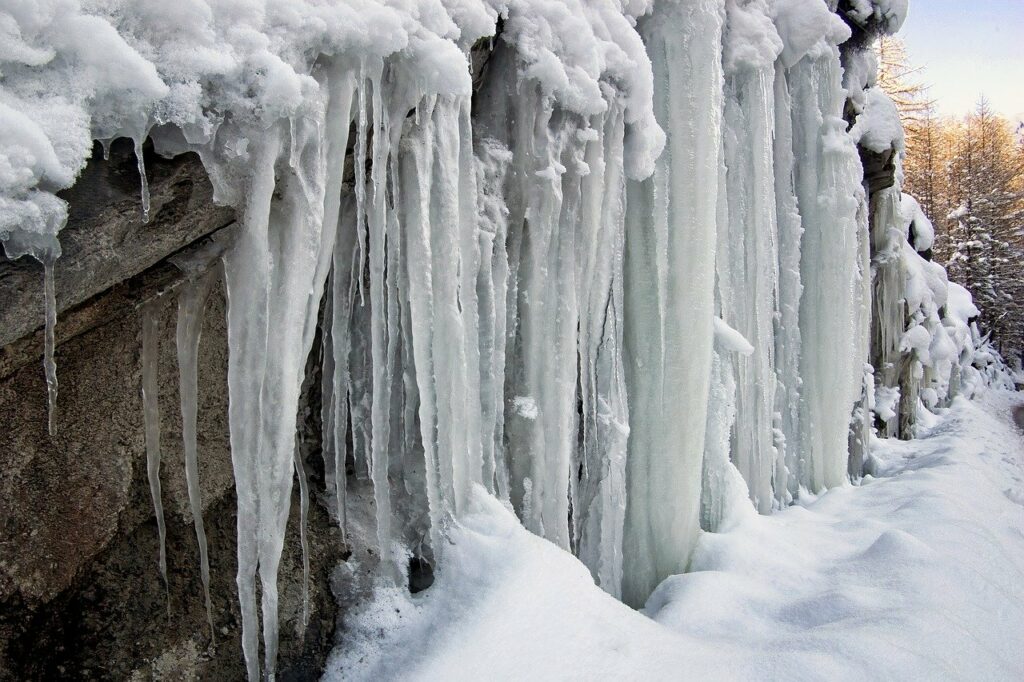Table of Contents
ToggleIce Climbing For Beginners
Understanding Ice Climbing
Ice climbing is a thrilling and challenging sport that truly tests your mettle. It involves the ascent of frozen waterfalls, ice formations, or icy rock faces using specialized climbing gear such as ice axes, crampons, and ice screws. This sport is not for the faint-hearted, but for those who love adventure and aren’t afraid to face the elements, ice climbing can offer an unparalleled adrenaline rush.
Ice Climbing vs Rock Climbing
Compared to rock climbing, ice climbing presents a unique set of challenges and requires specialized equipment. In rock climbing, climbers use their hands and feet to find holds on the rock surface. On the other hand, in ice climbing, climbers use ice axes and crampons to create their holds in the ice.
Another key difference lies in the nature of the climbing surface. Rock surfaces are generally solid and stable, while ice can vary greatly in condition and stability, making ice climbing a more dynamic and unpredictable sport.
When it comes to gear, ice climbers need to equip themselves with tools specifically designed for ice. This includes ice climbing boots, crampons, ice axes, and sometimes even ice screws. One of the primary tools in ice climbing is the ice axe, which is used to swing into the ice and create holds for the climber to ascend. Crampons, metal spikes attached to the bottom of boots, provide traction on the slippery ice.
Safety is paramount in both sports, but ice climbing brings additional risks. The potential for falling ice, the changing nature of the ice surface due to temperature fluctuations, and the need for proper anchoring techniques all contribute to the complexity of this sport.
For those ready to embrace the chill and excitement, ice climbing for beginners can be a fantastic pursuit. As with all outdoor adventures, getting proper training and guidance before you start is crucial. You might want to check out our guide on ice climbing training for more information on how to start your ice climbing journey.
For the more experienced climbers looking to make the switch from rock to ice, understanding these differences is the first step. The transition may be challenging, but the rewards of conquering a frozen waterfall are well worth it.
Preparing for Ice Climbing
Before venturing into the icy world of ice climbing, it’s essential to be adequately prepared. This preparation includes physical training and ensuring that you have the right gear.
Physical Preparation for Ice Climbing
Ice climbing is a physically demanding activity that requires strength, endurance, and balance. If you’re new to this, it’s essential to build up a good level of fitness and strength before attempting ice climbing. This includes regular cardiovascular exercises such as running or cycling, as well as strength training, especially focusing on your core and upper body.
Also, practicing rock climbing can be a great way to develop the necessary strength and techniques, as many of the skills are transferable. However, ice climbing does require its own unique set of skills, and beginners should consider taking an introductory course or hiring a guide to learn the necessary techniques for safe ice climbing. You can find more information about this in our section on ice climbing training.
Essential Ice Climbing Gear
Having the right gear is another critical part of preparing for ice climbing. Your gear should include warm and waterproof layers, insulated boots, and helmets to protect you from the elements and any potential falling ice.
In addition to clothing, ice climbing requires specialized gear such as crampons, ice axes, helmets, harnesses, and boots with a rigid sole for attaching crampons.
Here’s a basic gear list for ice climbing:
- Ice climbing axes
- Ice climbing boots
- Ice climbing crampons
- Ice climbing gloves
- Ice climbing harnesses
- Ice climbing helmets
- Ice climbing ropes
Remember, safety is paramount when ice climbing. Always ensure your gear is in good condition and is suitable for the conditions you’ll be climbing in. For more information on this, refer to our section on ice climbing safety.
Ice Climbing Techniques
Once you’ve got your essential gear and are physically prepared, it’s time to learn some basic ice climbing moves and safety techniques. These skills are the foundation of safe and enjoyable ice climbing.
Basic Ice Climbing Moves
Ice climbing requires a unique set of moves, quite different from rock climbing. One fundamental technique is the use of crampons and ice axes. Crampons, attached to your ice climbing boots, provide traction on ice, while ice axes, also known as ice climbing axes, offer grip and balance.
One common technique is “front-pointing,” where you kick the front spikes of your crampons into the ice and then swing your ice axe into the ice above you. This is followed by pulling yourself up with your arms and pushing with your legs. You’ll alternate these steps as you ascend the ice.
Remember, it’s not all about upper-body strength; your legs are doing the heavy lifting. This is a physical sport, requiring strength and endurance, but the right technique makes a significant difference.
Safety Techniques in Ice Climbing
Safety should be your top priority. Ice climbing poses unique challenges compared to rock climbing, such as dealing with sub-zero temperatures, fragile ice formations, and the risk of avalanches. Thus, understanding and implementing safety techniques are crucial.
First, always climb with a partner and stay tied in to your rope for security. Ensure you’re using appropriate gear, such as helmets, to protect against falling ice.
Second, practice placing ice screws, a type of protection used in ice climbing. They are inserted into the ice and connected to your rope to catch you in case of a fall.
Third, constantly assess the ice conditions. Ice can change rapidly, and it’s important to recognize unsafe conditions, such as thin or rotten ice.
Lastly, be avalanche aware. Ice climbs are often in avalanche terrain, so knowing how to assess the risk is essential.
For beginners, it’s recommended to start with a guided trip to learn these techniques and safety measures under the supervision of experienced climbers.
There’s a lot more to learn, and I recommend checking out our detailed guide on ice climbing techniques and ice climbing safety for a deeper dive into these topics.
Starting Ice Climbing as a Beginner
So, you’re all set to start your ice climbing adventure? That’s fantastic! Here are a few tips and recommendations I have for you as you embark on this exciting journey.
Learning Ice Climbing with a Guide
Getting started with ice climbing can seem a bit daunting, but don’t worry, you’re not alone. It’s highly recommended that beginners start with a guided ice climbing trip. This will provide you with the opportunity to learn the basic techniques and safety measures necessary for ice climbing.
Another option is taking an introductory course or hiring a guide to learn the necessary skills and techniques for safe ice climbing. For example, Yamnuska Mountain Adventures offers private ice climbing courses for beginners, providing a safe and personalized experience.
Remember, it’s important to learn proper techniques before attempting ice climbing on your own. You can also further enhance your skills by checking out our comprehensive ice climbing techniques guide.
Top Beginner-Friendly Ice Climbing Destinations
Once you’ve learned the basics, you might be wondering where to head for your first ice climbing adventure. Here are a few beginner-friendly ice climbing destinations that are perfect for your first climb.
| Destination | Location |
|---|---|
| Ouray Ice Park | Ouray, Colorado, USA |
| Valdez Ice Climbing Festival | Valdez, Alaska, USA |
| Cogne Ice Opening | Cogne, Aosta Valley, Italy |
| Kandersteg Ice Climbing Festival | Kandersteg, Switzerland |
These destinations offer a variety of ice climbing routes that are suitable for beginners. Plus, they often host ice climbing festivals where you can meet other climbers, learn from experts, and even participate in workshops and competitions.
For more details on these and other fantastic ice climbing spots, check out our guide on the best ice climbing destinations.
Remember, the journey of ice climbing is as thrilling as reaching the top. Enjoy every moment of it, stay safe, and most importantly, have fun! I can’t wait to hear about your first ice climbing adventure. Happy climbing!
Tips for Ice Climbing
Embarking on an ice climbing adventure is thrilling, but it’s also essential to be prepared. Proper clothing, gear, and nutrition can make all the difference for a successful climb. In this section, I’ll provide some tips on dressing for ice climbing and staying hydrated and energized.
Dressing for Ice Climbing
When it comes to ice climbing, what you wear is crucial. As Outdoor Skills and Thrills emphasizes, you need warm and waterproof layers, insulated boots, and a helmet to protect you from falling ice.
Layering is a key strategy for dressing appropriately for ice climbing. As Vertical Addiction points out, you should start with a base layer that wicks moisture away from your body, followed by an insulating layer for warmth, and then a waterproof shell to protect you from ice and snow.
When choosing your boots, make sure they are insulated and waterproof, as recommended by TreeLine Review. Insulated boots will keep your feet warm in freezing conditions, and being waterproof ensures they stay dry. To learn more about the right boots for ice climbing, check out our guide to ice climbing boots.
Don’t forget about the helmet. A helmet is a must-have for protection from falling ice. You can find more information on choosing the right helmet in our ice climbing helmets guide.
Staying Hydrated and Energized
Ice climbing is physically demanding. As Climbing.com notes, it requires strength, endurance, and the ability to use specialized techniques. That’s why staying hydrated and energized is so important.
When you’re exerting yourself in cold conditions, it’s easy to underestimate how much water your body needs. Always bring plenty of water and make a point to drink it, even if you don’t feel thirsty.
As for energy, pack high-calorie snacks that you can eat easily on breaks. Foods like nuts, dried fruit, and energy bars are lightweight, non-perishable, and packed with the nutrients you need to keep going.
Remember, ice climbing is a challenging but rewarding sport. With the right preparation, you can have a safe and enjoyable experience. For more beginner tips, check out our guide on ice climbing for beginners.
Ice Climbing Destinations
Once you’ve familiarized yourself with the basics of ice climbing, you’ll be eager to put your skills to the test. Fortunately, there are plenty of destinations around the world that cater to ice climbers of all skill levels. Whether you’re embarking on your first climb or seeking a new challenge, these locations offer breathtaking landscapes and exciting climbs for everyone.
Popular Ice Climbing Spots in the US
The USA is home to several world-renowned ice climbing destinations. Here are some of the most popular:
- Ouray Ice Park, Colorado: Known for its more than 200 ice and mixed climbs, Ouray Ice Park is a top choice for ice climbers of all skill levels. Beginners can start with low-grade climbs while experienced climbers can tackle advanced routes.
- Bozeman, Montana: Offering a variety of ice climbs for beginners, Bozeman is known for its top roping and easy to moderate grade climbs.
According to a forum thread on Mountain Project, other notable ice climbing spots in the US include Cody, New Hampshire, Adirondacks (Keene Valley, NY), Ridgeway (in between Ouray and Telluride), and Whitegrass, Montana. Each of these locations offers a unique ice climbing experience, making them must-visit spots for any ice climber.
International Ice Climbing Destinations
If you’re looking to venture outside the US for your ice climbing adventures, you’re in luck. There are several fantastic ice climbing spots around the globe:
- Eidfjord, Norway: Known for its beginner-friendly ice climbing routes, Eidfjord offers easy top roping options and ice pillars suitable for beginners.
- Cogne, Italy: Cogne ice park is known for its range of difficulty levels, making it a great destination for beginners. It offers ice falls with a range of lengths and grades, perfect for those new to ice climbing.
Remember, safety should always come first on any ice climbing trip. It’s important to have the right gear, including axes, boots, crampons, and helmets. And don’t forget to check the conditions before you go.
For more information on the best ice climbing destinations, check out our article on best ice climbing destinations. Happy climbing!

